 Ce ebook est une compilation des contributions qui seront présentées lors du « Malaysian International Tribology Conference 2015 » (MITC2015) à Penang, en Malaysie du 16 au 17 Novembre 2015.
Ce ebook est une compilation des contributions qui seront présentées lors du « Malaysian International Tribology Conference 2015 » (MITC2015) à Penang, en Malaysie du 16 au 17 Novembre 2015.
Archives mensuelles : octobre 2015
Cracked Speed Boat Steering Wheel
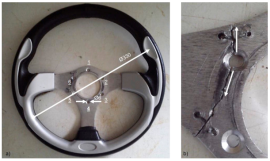 A Case study published in « Case Studies in Engineering Failures Analysis » of october 2015.
A Case study published in « Case Studies in Engineering Failures Analysis » of october 2015.
Failure of a cracked steering wheel is studied in this paper. Steering wheel, mounted on a speed boat, had cracks emanating from one of the fastener holes until final fracture occurred.Possible causes of crack occurrence include excessive fastener torque moment, fretting between fastener and hole combined with poor machining that left marks that serve as potential crack initiation points. Obtained results are valuable for predicting fracture behavior of the cracked steering wheel and can be taken as a reference for design and exploitation process of such component.
Wire breakage of Tyre bead grade
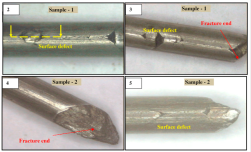 A new case study in « Case Studies in Engineering Failure Analysis » of October 2015.
A new case study in « Case Studies in Engineering Failure Analysis » of October 2015.
Tyre bead grade wire is used for tyre making application. The wire is used as reinforcement inside the polymer of tyre. The wire is available in different size/section such as 1.6 mm to 0.80 mm thin Cu coated wire. During tyre making operation at tyre Manufacturer Company, wire failed frequently. In this present study, different broken/defective wire samples were collected from Wire Mill for details investigation of the defect. The analysis revealed that, white layer of surface martensite was formed and it was caused the final breakage of wire. In this study they have also discussed about the possible reason for the formation of such kind of surface martensite (hard-phase).
Failure analysis of a leaked oil pipeline
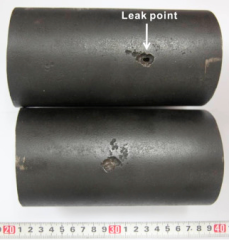 A new paper in « Case Studies in Engineering Failure Analysis« .
A new paper in « Case Studies in Engineering Failure Analysis« .
An oil pipeline embedded in an underground trench had failed. Through the accident investigation they found that there was a perforation at the leak point of the pipeline. After careful analysis it is concluded that the leakage of the pipeline was mainly caused by the liquid impingement erosion.
Journal of the Indian Institute of Science A Multidisciplinary Reviews Journal
 A publication of the « Journal of the Indian Institute of Science » about nanocomposites.
A publication of the « Journal of the Indian Institute of Science » about nanocomposites.
Fiber reinforced polymer (FRP) composites are widely used in structural applications, mainly due to their high specific strength and stiffness. These composites experience several types of static and fatigue loads in service. For a safe and durable structure, high fracture toughness and enhanced fatigue life are prominent requirements of these composite materials. Efforts have been made in recent times to improve the fracture toughness and fatigue properties of FRP composites by incorporation of second phase fillers in the epoxy matrix. Addition of nano sized fillers to the epoxy has led to the development of a new class of materials— polymer nanocomposites. The presence of nano fillers has been shown to improve the fracture toughness and fatigue life of bulk epoxies as well as FRPs with nano-modified epoxy matrix. The type of nano filler, its shape, size, volume fraction and dispersion in the epoxy have all been shown to influence these properties significantly. In this review, an overview on the effect of nano fillers on the fracture toughness and fatigue life of bulk epoxies and FRPs is presented. The mechanisms proposed for observed improvements in these properties and the empirical method of prediction of fatigue life of nanocomposites subjected to spectrum fatigue loads simulating service loads are also discussed.
Computational Investigation of Superalloy Persistent Slip Bands Formation
An interesting paper published in Proceedings of the 21st International Conference on Automation & Computing, University of Strathclyde, Glasgow, UK, 11-12 September 2015.
Persistent slip bands (PSB) is the important and typical microstructure generated during fatigue crack initiation. Intensive works have been done to investigate the mechanisms of the formation of persistent slip bands in the past decade. In this paper, a molecular dynamics (MD) simulation associated with embedded atom model (EAM) is applied on the PSBs formation in nickel-base superalloys with different microstructure and temperature under tensiletensile loadings. Simulation results show that PSBs formed within the 𝛄 phase by massive dislocations pile-up and propagation which can penetrate the grain. Also, the temperature will affect the material fatigue performance and blur PSBs appearance. The simulation results are in strong agreement with the experimental test results published before.
Flywheel starter ring gear failures and hardness variation reduction in surface hardening process
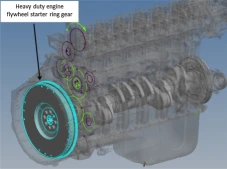 A new case study published in Case Studies in Engineering Failure Analysis. This technical paper summarizes the case study conducted for truck flywheel starter ring gears with diameter of 470 mm in order to reduce hardness variation by optimization of induction hardening and tempering processes.
A new case study published in Case Studies in Engineering Failure Analysis. This technical paper summarizes the case study conducted for truck flywheel starter ring gears with diameter of 470 mm in order to reduce hardness variation by optimization of induction hardening and tempering processes.
Nouveau robot portatif pour l’évaluation des contraintes résiduelles des pièces métalliques
 Le Cetim présent sur Enova 2015 a présenté pour la première fois le X-Raybot, un robot portatif dédié à l’évaluation des contraintes résiduelles des pièces métalliques par diffraction de rayons X, codéveloppés avec la société MRX.
Le Cetim présent sur Enova 2015 a présenté pour la première fois le X-Raybot, un robot portatif dédié à l’évaluation des contraintes résiduelles des pièces métalliques par diffraction de rayons X, codéveloppés avec la société MRX.
Lire l’article paru dans « Contrôles-Essais-Mesures »
Failure analysis of a Ti-6Al-4V ultrasonic horn used in cavitation erosion tests
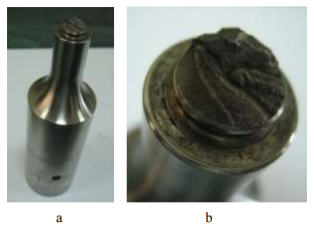 A paper published in MECHANIKA. 2015 Volume 21(4): 272–276.
A paper published in MECHANIKA. 2015 Volume 21(4): 272–276.
During the testing of the materials’ cavitation erosion resistance on vibratory systems by direct method (ASTM G32), the thread from the ultrasonic horn – test specimen connection, is subjected to fatigue. Operational experience has shown the occurrence of cracks and fractures in this area after a number of stress cycles that was lower than anticipated. The paper presents an analysis applied on four types of ultrasonic horns geometries: the original geometry with an external thread M12 and three modified geometries, with an internal thread M10 and M8. The four geometries were subjected to static analysis in order to determine the stress distribution. Based on static analysis, the behavior of the horns to fatigue was simulated and analyzed, determining the fatigue life, safety factors and optimal geometry.
